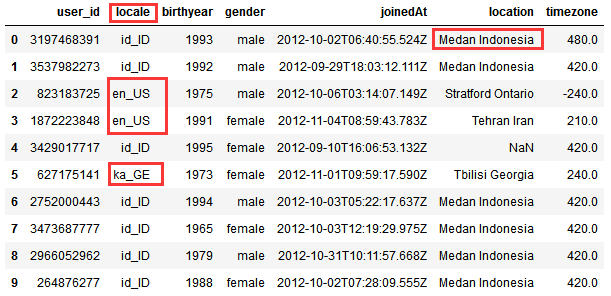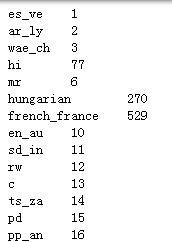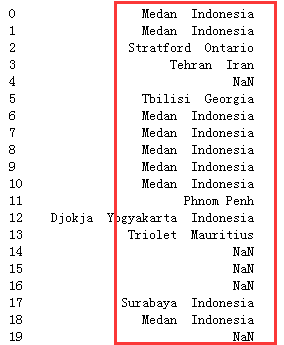一、请知晓
本文是基于Event Recommendation Engine Challenge分步解析第一步,需要读者先阅读上篇文章解析
二、用户相似度计算
第二步:计算用户相似度信息
由于用到:users.csv,我们先看看其内容(看前10行)
import pandas as pd
df_users = pd.read_csv('users.csv')
df_users.head(10)
结果如下,有国家,有地区:

我们使用locale和pycountry模块来将字符串转换成数值:
locale.locale_alias字典
import locale locale.locale_alias

下面我们来看看如何对users.csv的信息列进行处理,转换成数值型
1) locale列处理
import locale
from collections import defaultdict
localeIdMap = defaultdict(int)
for i, l in enumerate(locale.locale_alias.keys()):
localeIdMap[l] = i + 1
for each in localeIdMap:
print(each, ' ', localeIdMap[each])
代码示例结果:

所以传给localeIdMap一个locale的字符串,就可以将其转换成数值型,如果传入的字符串不在localeIdMap的key中,则返回0,这也就体现了defaultdict(int)的作用
print(localeIdMap['en_GB'.lower()]) print(localeIdMap['en_US'.lower()]) print(localeIdMap['id_ID'.lower()]) print(localeIdMap['ka_GE'.lower()])
代码示例结果:

2)birthyear列处理
该列处理比较简单,存在就直接转换成数值,不存在就用0填充
def getBirthYearInt(birthYear):
try:
return 0 if birthYear=="None" else int(birthYear)
except:
return 0
print(getBirthYearInt(1992))
print(getBirthYearInt(None))
代码示例结果:

3)gender列处理:male转换为1, female转换为2,空值用0填充
from collections import defaultdict
genderIdMap = defaultdict(int, {'male':1, 'female':2})
print(genderIdMap['male'])
print(genderIdMap['female'])
print(genderIdMap[None])
代码示例结果:

4)joinedAt列处理
我们发现该列信息有些共性特点:
import pandas as pd
df_users = pd.read_csv('users.csv')
df_users['joinedAt']
代码示例结果:

我们发现该列要么是None,要么是上面的时间字符串,均有T在中间和S在尾部,根据这个共性我们用datetime模块,提取时间信息:
import datetime
def getJoinedYearMonth(dateString):
try:
dttm = datetime.datetime.strptime(dateString, "%Y-%m-%dT%H:%M:%S.%fZ")
return "".join( [str(dttm.year), str(dttm.month)] )
except:
return 0
df_users['joinedAt'].map(getJoinedYearMonth)
代码示例结果(这里要注意dateString为None的情况,也就是说dateString必须符合后面的格式才行,所以这里加了try,但是except的返回值并不代表用0值填充合适)

5)location列处理
我们来看看users.csv中location列信息(前20行):
df_users['location']
代码示例结果:

我们使用pycountry模块来将此列转换为数值型,pycountry.countries是个迭代器:
import pycountry
for i, c in enumerate(pycountry.countries):
print(i, c)
代码示例结果:

import pycountry
from collections import defaultdict
countryIdMap = defaultdict(int)
for i, c in enumerate(pycountry.countries):
countryIdMap[c.name.lower()] = i + 1
for each in countryIdMap:
print(each, ' ', countryIdMap[each])
代码示例结果:

然后看看对location列是如何转换成数值型的:
import pycountry
from collections import defaultdict
countryIdMap = defaultdict(int)
for i, c in enumerate(pycountry.countries):
countryIdMap[c.name.lower()] = i + 1
def getCountryId(location):
if (isinstance( location, str)) and len(location.strip()) > 0 and location.rfind(' ') > -1:
return countryIdMap[ location[location.rindex(' ') + 2: ].lower() ]
else:
return 0
print(getCountryId('San Dimas California'))
print(getCountryId('Jogjakarta Indonesia'))
代码示例结果:

也就是location是字符串,不为空,并且从右边查询连续两个空格的索引大于-1,也就是存在两个连续空格,就获得两个空格后面的字符串,并转换为数值ID
6)timezone列处理:比较简单,存在值就转换为int型,不存在用0填充
def getTimezoneInt(timezone):
try:
return int(timezone)
except:
return 0
print(getTimezoneInt(-240))#-240
print(getTimezoneInt(240))
print(getTimezoneInt(None))
7)将上面处理的1-6列进行归一化
self.userMatrix矩阵的处理中归一化使用了sklearn.preprocessing.normalize()函数,归一化后方便计算两个user的相似度
这里只计算Event Recommendation Engine Challenge分步解析第一步中的uniqueUserPairs,他们因为同一个event事件关联起来了,有联系
计算相关性用到了scipy.spatial.distance.correlation(u, v) #计算向量u和v之间的相关系数(pearson correlation coefficient, Centered Cosine)
8)第二步完整代码
from collections import defaultdict
import locale, pycountry
import scipy.sparse as ss
import scipy.io as sio
import itertools
#import cPickle
#From python3, cPickle has beed replaced by _pickle
import _pickle as cPickle
import scipy.spatial.distance as ssd
import datetime
from sklearn.preprocessing import normalize
class ProgramEntities:
"""
我们只关心train和test中出现的user和event,因此重点处理这部分关联数据,
经过统计:train和test中总共3391个users和13418个events
"""
def __init__(self):
#统计训练集中有多少独立的用户的events
uniqueUsers = set()#uniqueUsers保存总共多少个用户:3391个
uniqueEvents = set()#uniqueEvents保存总共多少个events:13418个
eventsForUser = defaultdict(set)#字典eventsForUser保存了每个user:所对应的event
usersForEvent = defaultdict(set)#字典usersForEvent保存了每个event:哪些user点击
for filename in ['train.csv', 'test.csv']:
f = open(filename)
f.readline()#跳过第一行
for line in f:
cols = line.strip().split(',')
uniqueUsers.add( cols[0] )
uniqueEvents.add( cols[1] )
eventsForUser[cols[0]].add( cols[1] )
usersForEvent[cols[1]].add( cols[0] )
f.close()
self.userEventScores = ss.dok_matrix( ( len(uniqueUsers), len(uniqueEvents) ) )
self.userIndex = dict()
self.eventIndex = dict()
for i, u in enumerate(uniqueUsers):
self.userIndex[u] = i
for i, e in enumerate(uniqueEvents):
self.eventIndex[e] = i
ftrain = open('train.csv')
ftrain.readline()
for line in ftrain:
cols = line.strip().split(',')
i = self.userIndex[ cols[0] ]
j = self.eventIndex[ cols[1] ]
self.userEventScores[i, j] = int( cols[4] ) - int( cols[5] )
ftrain.close()
sio.mmwrite('PE_userEventScores', self.userEventScores)
#为了防止不必要的计算,我们找出来所有关联的用户或者关联的event
#所谓关联用户指的是至少在同一个event上有行为的用户user pair
#关联的event指的是至少同一个user有行为的event pair
self.uniqueUserPairs = set()
self.uniqueEventPairs = set()
for event in uniqueEvents:
users = usersForEvent[event]
if len(users) > 2:
self.uniqueUserPairs.update( itertools.combinations(users, 2) )
for user in uniqueUsers:
events = eventsForUser[user]
if len(events) > 2:
self.uniqueEventPairs.update( itertools.combinations(events, 2) )
#rint(self.userIndex)
cPickle.dump( self.userIndex, open('PE_userIndex.pkl', 'wb'))
cPickle.dump( self.eventIndex, open('PE_eventIndex.pkl', 'wb') )
#数据清洗类
class DataCleaner:
def __init__(self):
#一些字符串转数值的方法
#载入locale
self.localeIdMap = defaultdict(int)
for i, l in enumerate(locale.locale_alias.keys()):
self.localeIdMap[l] = i + 1
#载入country
self.countryIdMap = defaultdict(int)
ctryIdx = defaultdict(int)
for i, c in enumerate(pycountry.countries):
self.countryIdMap[c.name.lower()] = i + 1
if c.name.lower() == 'usa':
ctryIdx['US'] = i
if c.name.lower() == 'canada':
ctryIdx['CA'] = i
for cc in ctryIdx.keys():
for s in pycountry.subdivisions.get(country_code=cc):
self.countryIdMap[s.name.lower()] = ctryIdx[cc] + 1
self.genderIdMap = defaultdict(int, {'male':1, 'female':2})
#处理LocaleId
def getLocaleId(self, locstr):
#这样因为localeIdMap是defaultdict(int),如果key中没有locstr.lower(),就会返回默认int 0
return self.localeIdMap[ locstr.lower() ]
#处理birthyear
def getBirthYearInt(self, birthYear):
try:
return 0 if birthYear == 'None' else int(birthYear)
except:
return 0
#性别处理
def getGenderId(self, genderStr):
return self.genderIdMap[genderStr]
#joinedAt
def getJoinedYearMonth(self, dateString):
dttm = datetime.datetime.strptime(dateString, "%Y-%m-%dT%H:%M:%S.%fZ")
return "".join( [str(dttm.year), str(dttm.month) ] )
#处理location
def getCountryId(self, location):
if (isinstance( location, str)) and len(location.strip()) > 0 and location.rfind(' ') > -1:
return self.countryIdMap[ location[location.rindex(' ') + 2: ].lower() ]
else:
return 0
#处理timezone
def getTimezoneInt(self, timezone):
try:
return int(timezone)
except:
return 0
class Users:
"""
构建user/user相似度矩阵
"""
def __init__(self, programEntities, sim=ssd.correlation):#spatial.distance.correlation(u, v) #计算向量u和v之间的相关系数
cleaner = DataCleaner()
nusers = len(programEntities.userIndex.keys())#3391
#print(nusers)
fin = open('users.csv')
colnames = fin.readline().strip().split(',') #7列特征
self.userMatrix = ss.dok_matrix( (nusers, len(colnames)-1 ) )#构建稀疏矩阵
for line in fin:
cols = line.strip().split(',')
#只考虑train.csv中出现的用户,这一行是作者注释上的,但是我不是很理解
#userIndex包含了train和test的所有用户,为何说只考虑train.csv中出现的用户
if cols[0] in programEntities.userIndex:
i = programEntities.userIndex[ cols[0] ]#获取user:对应的index
self.userMatrix[i, 0] = cleaner.getLocaleId( cols[1] )#locale
self.userMatrix[i, 1] = cleaner.getBirthYearInt( cols[2] )#birthyear,空值0填充
self.userMatrix[i, 2] = cleaner.getGenderId( cols[3] )#处理性别
self.userMatrix[i, 3] = cleaner.getJoinedYearMonth( cols[4] )#处理joinedAt列
self.userMatrix[i, 4] = cleaner.getCountryId( cols[5] )#处理location
self.userMatrix[i, 5] = cleaner.getTimezoneInt( cols[6] )#处理timezone
fin.close()
#归一化矩阵
self.userMatrix = normalize(self.userMatrix, norm='l1', axis=0, copy=False)
sio.mmwrite('US_userMatrix', self.userMatrix)
#计算用户相似度矩阵,之后会用到
self.userSimMatrix = ss.dok_matrix( (nusers, nusers) )#(3391,3391)
for i in range(0, nusers):
self.userSimMatrix[i, i] = 1.0
for u1, u2 in programEntities.uniqueUserPairs:
i = programEntities.userIndex[u1]
j = programEntities.userIndex[u2]
if (i, j) not in self.userSimMatrix:
#print(self.userMatrix.getrow(i).todense()) 如[[0.00028123,0.00029847,0.00043592,0.00035208,0,0.00032346]]
#print(self.userMatrix.getrow(j).todense()) 如[[0.00028123,0.00029742,0.00043592,0.00035208,0,-0.00032346]]
usim = sim(self.userMatrix.getrow(i).todense(),self.userMatrix.getrow(j).todense())
self.userSimMatrix[i, j] = usim
self.userSimMatrix[j, i] = usim
sio.mmwrite('US_userSimMatrix', self.userSimMatrix)
print('第1步:统计user和event相关信息...')
pe = ProgramEntities()
print('第1步完成...
')
print('第2步:计算用户相似度信息,并用矩阵形式存储...')
Users(pe)
print('第2步完成...
')
针对该步使用的变量作简单介绍:
self.userMatrix:user稀疏矩阵,shape为(3391,6),3391为train和test中出现的所有user,6列为users.csv中后面user的6列信息,并且已经做了数值转换和归一化
self.userSimMatrix:用户相似度稀疏矩阵,shape为(3391,3391),这里只计算了分步解析第一步中uniqueUserPairs,我们只需要计算出对同一个event有响应的用户之间的相似度,uniqueUserPairs保存了这样的UserPair
import pandas as pd round(pd.DataFrame(userSimMatrix))
代码示例结果:


userSimMatrix:用户相似度稀疏矩阵,同一个event有响应的用户之间的相似度
至此,第二步完成,哪里有不明白的请留言